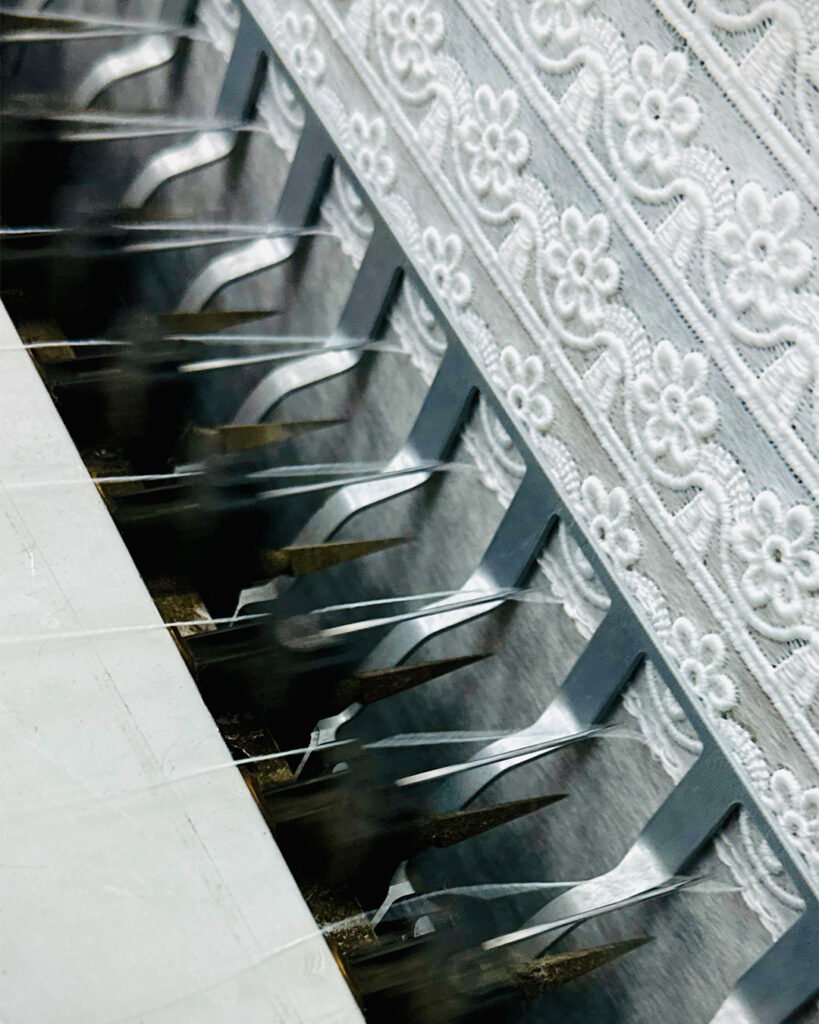
Within the realm of textile embellishment, Pakistan warrants much reverence. With all its artsy instrumentalities, age-old traditions, and robust manufacturing capabilities in place, the country has thus established itself as an international center for embroidery manufacturing. To international brands and designers whose gamut extends from high-street fashion houses to luxury haute couture clothing, Pakistan stands as the promised land of supreme quality, innovations, and craftsmanship. So what is it exactly that the country is providing the world outside that has everyone raring to go? Through this article, an attempt is made to trace the social, textile, and economic history of embroidery from Pakistan, gathering momentum to become a very important driving force in the industry.
The History of Pakistani Embroidery: A Legacy Woven Through Time
Pakistani embroidery is an ancient art passed on through the ages from one generation to another. This ancient art originated during the Mughal Empire, mainly through the introduction of works of Zari, heavy embroidery, whereby gold and silver threads are used for magnificent patterns.
Over time, imperial influences became fused with those of the native styles from different areas, creating an arsenal of techniques that give unique cultural stories.
This deep history is not just a cultural artifact but something that lives. As our results indicate, it’s the ideal combination of culture and art that has survived the years, stitching artisans to their past and identity through every thread.” Such a mastery is the first pillar of global dominance for the country.
Tapestry Techniques: Matchless Regional Expertise
The real strength of Pakistan is in the different styles of embroidery, each of which can be distinguished by a specific region and identity. This variety gives international buyers an unparalleled portfolio of craftsmanship.
With the word “Phulkari,” which literally means “flower work,” this is where rich geometric floral patterns are embroidered in bright silk or cotton threads to catch bursts of colors on shawls and dupattas.
- Sindhi Embroidery (Sindh): The instantly identifiable pattern for this embroidery is its sparkling mirror and bright geometrical designs. Indeed, it is a symbolic and decorative style since mirrors have the reputation of warding off evil spirits.
- Characteristic Balochi Tanka (Balochistan): It has very bold, rebellious stitches and bright, contrasting colors. This is the imagery of the Baloch people’s struggles and pride.
- Zardozi and Kamdani: The very best. It is a true splendor by using precious metal threads and forming huge, garish patterns out of them, making the very backbone of bridal as well as high fashion all over the world.
Such specialization at the regional level brings together a highly concentrated corpus of anima artisans of this specific technique, thus maintaining authenticity and expertise, which, elsewhere, is quite difficult to reproduce.
The Economic Powerhouse: Scale, Employment, and Export
Embroidery has been a major economic generator in Pakistan, besides being part of art. The numbers speak for themselves:
- The textile industry is generally considered the backbone of the economy, and embroidered textiles have played a central role in making it a truly international market.
- The sector holds employment opportunities for a vast number of people, especially women. It is estimated that 70 percent of rural women are engaged in textile-based work, mainly embroidery, making it a lifeline and source of income and empowerment for them.
- Most such organizations are meant to safeguard the business interests of the exporters as well as promote ethical manufacturing practices so that the industry grows smoothly. One such organization is the Pakistan Readymade Garments Manufacturers and Exporters Association (PRGMEA).
| Aspect | Detail | Significance |
| Women’s Employment | ~70% of rural women in textile-based work | Empowers women, supports rural economies |
| Artisan Earnings | Avg. PKR 15,000-20,000/month from embroidery | Provides a sustainable livelihood for families |
| Export Value | Key component of Pakistan’s textile exports ($15.4B in 2020-21) | Drives national economic growth and foreign exchange |
Features of the Pakistani Embroidery Industry
While the Pakistani embroidery sector, on the other hand, enters into dialogues concerning past techniques and modern innovation relevant to the craft, it creates a fusion design: designers reinterpret traditional patterning into modern silhouettes made in bold color juxtapositions on contemporary materials like sequins and metallic yarns.
- Technical Integration: From advanced Schiffli technology for precision down to e-commerce sites that connect artisans with end shoppers worldwide, technology is used at practically every facet of the craft.
- New Age-Enabling Operations: Eco-fashion is a rapidly growing movement today toward sustainable developments, organic fabric-making, natural dyeing, and ethical production methods.
In this flexibility resides the very soul that ensures the excellence of Pakistani embroidery, which continues to receive its share of attention even on the international scene.
Pakistan vs. The World: A Comparative Perspective
Is Pakistan in line with major manufacturing centers such as India, China, and Turkey?
India: Just like its full-fledged manufacturing zones, India, too, offers tailoring techniques like Chikankari, whereas Pakistan often stands out in terms of density, weight, and opulence of bridal and formal wear embroidery, especially that of Zardozi.
China: For China, it is volume, punctuality, and machine-made embroidery; unmatchable skill in hand embroidery, and artisanal quality are what Pakistan has been recognized for. Allied to that, an entirely different market segment of much greater value is usually found occupied by Pakistan.
Turkey: Except for the best quality, Turkey is known for its location-wise strategic reasons. However, Pakistan’s own competencies are invincible: unique regional techniques of Phulkari and Sindhi mirror work with cost efficiency and high-quality artisan labor.
Pakistan’s value proposition is distinctive for the sheer scale of semi-mass production of hand-embroidered, super-detailed embroideries that no one else could manage to straddle the balance of either.
The Road to a Bright Future in Sustainability
Pakistani embroidery has a bright prospect with attention on preservation infused with innovation. This is, of course, on:
- International Collaborations: Pakistani designs and techniques today are being marketed at international fashion weeks, and luxury brands are taking them to empower them on the global front.
- Empowering Artisans: NGOs and brands are working towards artisan communities within the industry to be sustainably compensated and to practice ethical procedures.
- Digital Reach: E-commerce can reach the smallest artisans across the globe, so traditional art will be able to find its audience all across the world through this e-channel.
Dilemmas in Preserving the Future: The Way Forward
Next on the agenda is making all of the country’s upcoming embroidery lights abroad shimmery and luminous, as sustainable as ever, with promises of keeping it fresh by staying on the path of innovation. International Collaborations Here, Pakistani designs and techniques are showcased at international fashion weeks, embraced by luxury brands for making their presence felt on the international stage. The little bits of power through which the artisans can become empowered will have themselves charted through the course trailblazed by others.
- Global Collaborations: Pakistani designs and techniques are being thrown on an international stage at international fashion weeks and adopted by luxury brands, thus adding to their power.
- Financial Empowerment to Craftspersons: Continuous development initiatives by both the NGOs and the brands will be critical components of the fair wages and ethical practices to keep the artisan communities sustained on the basis of the industry-making foundation.
- Digital Reach: Now, e-commerce can almost even reach the smallest artisans across the globe, meaning that traditional art will be able to find its audience around the world through this particular e-channel.
Conclusion: The Incontestable Mark of Authority
Pakistan is not naturally gifted with the title of the world. It has, for some time, an extremely long legacy, an unequaled variety in techniques, a large-scale economy, and a future-leaning innovation and sustainability attitude. For an organization like Famous Embroidery, which operates within this textile ecosystem, manufacturing means much more than the mere business of custodians of an art form that we are. So for much of the time, we have been using this public authority to bring unparalleled quality and creativity to the benefit of our customers worldwide.
Sourcing from Pakistan does not mean buying embroidery; it means investing in an artwork, which is a story thousands of years in the making, and a community of artisans whose abilities surpass anything you can imagine. This is the authority behind every stitch.
So work with Famous Embroidery to put Pakistan’s fine craftsmanship into your collection. Check out our capabilities, and let’s create something exceptional.
FAQs
1) What makes Pakistan the world’s best at embroidery?
Pakistan’s heritage is from the time of the Mughals, and these techniques, like Zardozi and Phulkar, have been passed down through the generations by the artisans. The traditional artisan techniques had brought the country, on one hand, to the modernization of the textile industry of the country, which had helped the country turn into a top supplier of the world’s imports of embroidered goods.
2) How do their works compare with those of Indian, Chinese, and Turkish embroiderers?
Excels in Chikankari, as conferred upon India, while mass production is best done and at its very competitive heights with China, but the difference is that Pakistan is a master of artisanal craftsmanship with its intricately hand-woven designs. Turkey is quite underlining concerning machine embroidery, while Pakistan believes in the charm of versatility, doing it both ways, and providing sustainable living as well as the presentation of cultural impressions, Sindhi mirror-work, Balochi Tanka, and more.
3) How is embroidery relevant in the economy of Pakistan?
Embroidery is a great export sector that has much to hold in the whole industry of textiles, with $15.4 billion in annual exports so far. It is empowering rural artisans, especially women, providing income as well as heritage preservation, and supplying to global brands and foreign luxury markets.
4) Is embroidery manufacturing innovative in Pakistan?
Pakistan is blending traditional techniques of embroidery with machine technology, where embroidery is done with indigenously designed machines for precision and mass scale. It adds contemporary products like sequins but adopts classical threads as a design. Therefore, domestic and international access to artisans’ products has been increased through e-commerce ventures.
5) Why are they sourcing way embroidery from Pakistan?
One is that they believe Pakistan is a cheap place. Secondly, their craftspeople are extremely good at what they do, and they can produce both very high-end pieces of work, such as bridal, or bulk for mass production, entirely machine-made. ISO certification further makes it possible that quality is ensured, thereby making Pakistan a trusted hub for its military, fashion, and home textiles.

